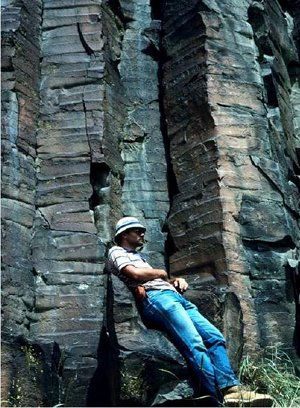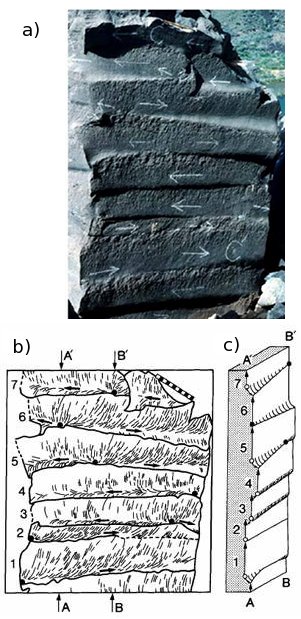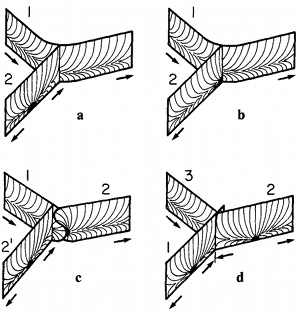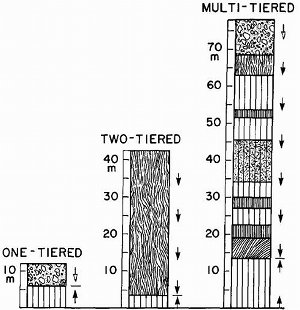| |||||||
|
|
|||||||
|
|
|||||||
| Growth of Columnar Joints | |||||||
|
The growth of columnar joints is an incremental process as inferred from the morphology of the joint surface features commonly called striations (Figure 1). Each joint increment appears as a band representing a discrete fracturing cycle as recorded by an initiation point or origin, hackle marks indicating local propagation direction, and termination front or arrest line (Figure 2), the collection of which describes the temporal and spatial evolution of the growth of a polygonal joint system. The initiation points and the arrest lines of the adjacent segments reveal the vertical and lateral evolution of the system. Contrary to common perception, vertically adjacent segments are not generally connected along the entire tip lines of the older segments and the consecutive segments are not initially in the same plane. After starting from a point on the tip line of the previous segment, the newer segment propagates predominantly laterally along the edge of the previous segment beyond the tip line (Figure 2). However, the older segments guide the newer ones and maintain the overall verticality of column faces, albeit with slight adjustments in the orientation of the newer segments from one level to the next. Each increment is also restricted in the lateral direction by the older neighboring fracture segments or column faces as illustrated in a series of diagrams in Figure 3. These diagrams show the kinematics of various types of lateral intersections at the so-called triple junctions. The orthogonal or T-intersections are no different than other orthogonal fracture types including the tectonic joints in sedimentary rocks. The non-orthogonal or Y-intersections which are more characteristic of thermal or desiccation fractures are commonly of two types: In the first, a segment terminates at a curvilinear fracture (3a) or emanates from it (3b), while the second includes three laterally intersecting segments with various intersection angles and relative ages (3c and d). Based on the field data presented above and mechanical models to be presented under the link, 'Mechanisms and Mechanics of Thermal Fractures,' columnar joints are known to initiate from the outer boundaries (cooling surfaces) and propagate inward towards the interior in a cyclic fashion. If a flow is very thin, then only a single-tier column may be present (Figure 4). For moderately thick flows, two-tier columns are common, corresponding to dual vertical propagation direction and different cooling rates as described in other links related to columnar joints. Multi-tier columns are also present, especially in thick flows and those flows are subjected to variable cooling regimes due to the interplays between the geological and hydrological systems.
| |||||||
| Reference: |
|||||||
| Aydin, A., DeGraff, J.M., 1988 DeGraff, J.M., Aydin, A., 1987 DeGraff, J.M., Aydin, A., 1993 Lore, J., Aydin, A., Goodson, K., 2001 Ryan, M.P., Sammis, C.G., 1981 |
|||||||
|
Readme | About Us | Acknowledgement | How to Cite | Terms of Use | Ⓒ Rock Fracture Knowledgebase |
|||||||



